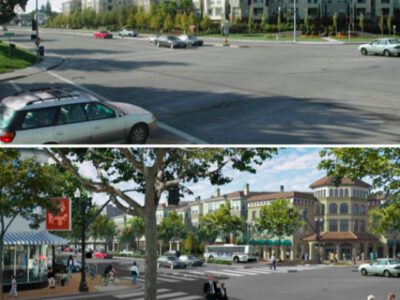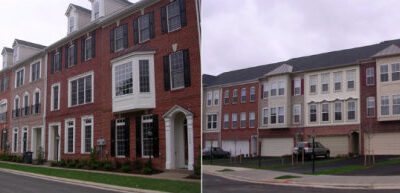We Built This City On Urban Form
California’s CEQA reforms will require rethinking how we code our cities
I am one of the relatively few observers who is not convinced that the California Legislature’s recent CEQA reforms are some sort of major transformation. They are a positive step toward building more housing in this state, but the idea that they will unleash housing construction and affordability is a classic case of overpromising – which should be unsurprising, since they are basically a vehicle for Gavin Newsom’s Presidential campaign (making the assumption that we ever have free and fair national elections again). And it certainly is not the case that the reforms represent environmental destruction. As Bill Fulton recently noted, the housing reforms only cover infill development, even if they increase the size of the infill exemption:
“Republicans in the legislature noted that greenfield projects will still be just as stuck in the CEQA quagmire as ever. They pointed in particular to last week’s appellate court ruling in the case involving the Tejon Ranch’s Centennial project in the Antelope Valley, noting that after many years the company will have to re-do the Centennial environmental impact report yet again…Similarly, the changes don’t help a big greenfield project like California Forever in Solano County, which will also still have to go through the CEQA grind.”
Hmmm…you mean greenfield projects remain subject to CEQA scrutiny, but infill ones don’t??!! That’s the whole goddamn point! Under the old CEQA, greenfield projects got an advantage because they were built far away from angry neighbors. That has ended, and it is a very good thing.
There is one place, however, where California local governments must move swiftly: urban form.
Under the old CEQA dispensation, local governments could review (and review and review) design features and the form of the project under an EIR. Now they can’t. But does that mean they lack the power to do so? Not at all. They just have to do it as part of the zoning code – which honestly, is where it should be.

Take a look at these two renderings. As a matter of zoning coding, they basically do the same thing: the planners wanted high density near a transit stop (in this case a bus stop), and they got it. But of course the first image is a planning disaster and the second one begins to look more like what we think of as new urbanism.

So what’s the difference? As much as anything else, the second image carefully considers not just use, but the relationship of the use to other uses, and most importantly, the relationship of all uses to the street. Are these streets where people want to be? If all you do is code for density, units/acre, but don’t think of the street, you will wind up with the first image, and maye even worse: you might have a street full parking garages on the first floor with the housing above the parking.
Under the old CEQA dispensation, some of this could be corrected for in the environmental review process, although very often it wasn’t. But because it could be, planners (and their lawyers!) didn’t think about it. Now they have to.
And importantly, you can code for this. It isn’t rocket science, and it isn’t magic. It just requires thought at the outset. The most typical way of thinking about this is in the notion of a Form-Based Code, which lots of people think – wrongly — is about whether you have pretty pink brick facing on buildings. A Form-Based Code regulates, well, form, that is, how uses interact with streets in order to create places. Form-Based Codes can be very detailed, but they are often far less complex than traditional codes because you don’t need to regulate hundreds of uses in them.
What the CEQA reform tells planners is to get to work on doing this sort of stuff – which really, is probably why they got into the planning business in the first place, viz. to make good urban spaces.
There is one fairly large practical caveat to all this: if it means retooling codes, then of course someone needs to do it, and particularly given the federal government’s war on cities, budgets will be very tight. Los Angeles itself has a nearly $1 billion deficit. But: 1) all those planners who needed to work on CEQA compliance can now actually do coding; and 2) this is where help from universities and nonprofits can really be of use. I don’t want to sugarcoat the real fiscal constraints here, but this is doable if it becomes a priority for cities. And the CEQA reform has told cities that it must be.
Reader Comments
4 Replies to “We Built This City On Urban Form”
Comments are closed.







Interesting question. Can one through code reform accomplish more efficiently what CEQA tried to do in assessing the whole context of a project instead of just narrow site- specific impacts of a project. Nothing legally prevents it, but practically fiscal constraint, politics, bureaucracy and in some cities corruption says it will not happen. Remains to be seen.
In principle, denser infill development should mean more taxable square footage of residential and/or commercial space per acre, or per block, or per square mile, or however you choose to measure it. These additions to the tax base should be more than enough to pay for the planning time required to get there. I realize there’s still a cash flow question—staff needs to be paid now, while tax will only come later. But on balance, it seems like a sound business proposition Unless all that new housing drives down housing prices so much that there’s no net increase in property taxes, but we’re far from that at the moment.
I must have missed something. Where in the smashing of environmental protections in urban areas was there an emphasis put on quality of life?
If I thought the two were at all related, I might be a lot less upset.
Walkability etc is expensive. That’s why it doesn’t get done *now.* What has changed? Are you imagining that the costs savings are going to be passed along? I don’t get it.
Infill housing… with separation from medium-industrial, or – or sometimes light industrial as a buffer? Okay, that can be okay.
But separation from freeways? Would like to see some data, but anecdotally, it seems that that’s prime infill space.
New housing – with reasonably competent input from the city – will get walls resistant to vibration and mechanical ventilation… But this is the future? Windows closed all the time?